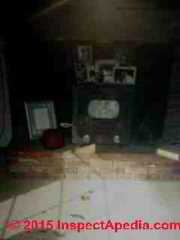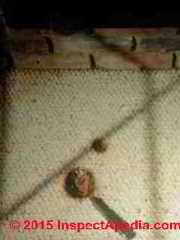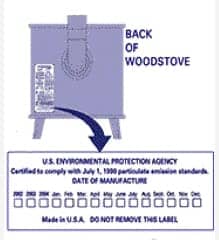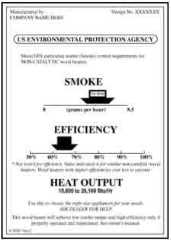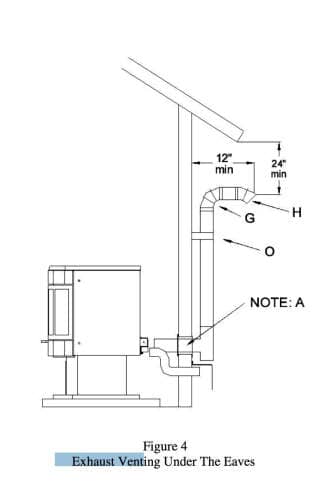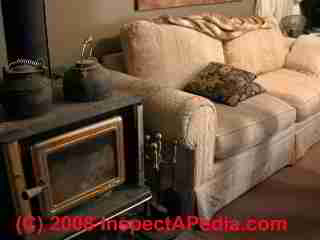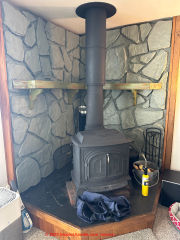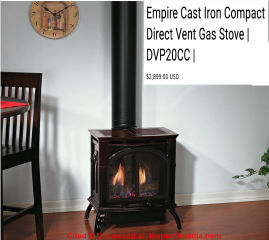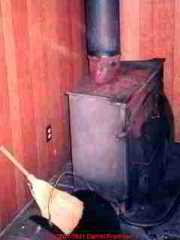 Fire Clearances, Installation Standards, Codes for Coal Stoves, Pellet Stoves & Wood stoves
Fire Clearances, Installation Standards, Codes for Coal Stoves, Pellet Stoves & Wood stoves
Fire clearance distance reduction using heat shields
- POST a QUESTION or COMMENT about fire safety clearances for woodstoves and coal stoves
Woodstove fire clearance distance specifications:
This article describes fire safety distances required between wood stoves and coal stoves and the nearest combustible surface.
We discuss child safety zones around wood and pellet stoves, the fire clearances for listed and un-listed wood or pellet stoves, and the construction and installation of a heat shield to reduce the required fire clearance distances around wood heating appliances.
The article includes standards for wood or pellet stove installations for various countries and it concludes with photos and descriptions of unsafe wood stove installations.
We discuss fire clearance distance specifications for wood stoves or coal stoves. Wood stove & pellet stove installation codes & standards, listings, labels, certifications. Wood stove or pellet stove heat shield construction & installation specifications.
Examples of unsafe wood stove installations. Comments on NFPA 211 "Standard for Chimneys, Fireplaces, Vents, and Solid Fuel-Burning Appliances".
InspectAPedia tolerates no conflicts of interest. We have no relationship with advertisers, products, or services discussed at this website.
- Daniel Friedman, Publisher/Editor/Author - See WHO ARE WE?
Fire Clearances for Flues for Woodstoves & Coal stoves
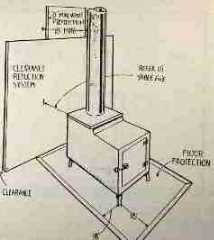 Our photo at the top of this page shows an unsafe wood fireplace installation that lacks adequate clearance from combustibles.
Our photo at the top of this page shows an unsafe wood fireplace installation that lacks adequate clearance from combustibles.
Notice also that the connection between the fireplace top and the flue is upside-down and that considerable leakage has occurred out of the flue onto the fireplace top.
Some basic rule of thumb fire clearances for woodstoves are shown in the sketch at left.
[Click to enlarge any image]
Watch out: Check with your local fire marshall about local building code requirements for fire-clearance distances before installing and using a wood stove, coal stove, or other auxiliary heat source.
Making a mistake can lead to a dangerous building fire.
Child safety: 36" safety zone around Wood Stoves & Pellet Stoves
Watch out: Use whatever means necessary to create a 36-inch safety zone around any heating equipment that can get hot enough to burn a child.
Keep small children out of this space.
Specific Fire Safety Clearance Distances for Un-Certified Wood Stoves & Pellet Stoves
In the U.S. certification is monitored by the U.S. EPA who provide a List of EPA Certified Wood Heaters given below. The Canadian Standards Association (CSA) and the U.S. Wood Heat Safety Organization also provide consistent recommendations for wood stoves that are not carry a certification label. Certifying agencies and standards for other countries are given below.
[Click to enlarge any image]
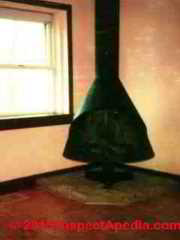 Fire safety clearance distances are measured from the closest point of the outer surface of the heating appliance to the closest point of nearby wall, floor or ceiling or to other combustible materials that might be nearby.
Fire safety clearance distances are measured from the closest point of the outer surface of the heating appliance to the closest point of nearby wall, floor or ceiling or to other combustible materials that might be nearby.
The wall finish surface, such as drywall is not considered in evaluating the heat resistance or fire safety of the heating appliance.
At left is a free-standing wood-burning fireplace installed by the author in the 1970's. Installation was incomplete - no adequate fire shielding was yet provided for this heater.
I (DF) lived with this stove as a sole heat source in a different home in the early 1970's and can tell you it is not a design I recommend. I would not install this fireplace today.
Watch out: the free-standing fireplace shown is not a safe installation. While it had a damper controlling the flue to slow burn rate the front of the stove was open except for a screen - a big heat loser for the building as combustion can only be controlled by intelligence: don't build a big fire.
And the installation as shown does not meet required clearances to combustibles.
- Un-certified woodstove clearance distances: 48" to combustibles at sides, rear, and corners
as well as the "fueling" or or ash removal side of the the heater. This distance might be reduced to 36" with an approved heat shield. - Un-certified woodstove clearance distance: 60' above the stove top
to the ceiling or any combustible above the heater. - Un-certified woodstove clearance distances when the stove has a sheet metal jacket or casing = 36" to combustibles
General Fire Safety Clearance Distances for Listed or Certified Wood Stoves & Pellet Stoves
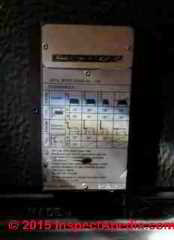 at left is the permanently affixed certification and data tag from a Jotul No. 118 wood stove that has been in service for more than 20 years in New York. The company's data tag includes woodstove fire clearance distances as marked.
at left is the permanently affixed certification and data tag from a Jotul No. 118 wood stove that has been in service for more than 20 years in New York. The company's data tag includes woodstove fire clearance distances as marked.
[Click to enlarge any image]
Watch out: Check with your local fire marshall about local building code requirements for fire-clearance distances before installing and using a wood stove, coal stove, or other auxiliary heat source.
Also check the specific fire clearance distance recommendations provided by the manufacturer of your wood burning appliance.
Making a mistake can lead to a dangerous building fire. In some jurisdictions for certified woodstoves clearance distances permitted may be as follows:
- Clearance from woodstove to unprotected surfaces or combustibles = 36" in any direction
Typical clearance between a wood or coal fired heater and the nearest combustible surface is 36" unless approved heat shields have been installed.
The free-standing fireplace (photo at page top) is less than 12" from wood paneling which is in turn installed on a wood-framed wall - this is an unsafe installation that should not be used.
Note that drywall mounted on wood-framed walls is considered a "combustible wall" for clearance distance purposes.
Note that some jurisdictions may require a greater distance between the wood or pellet stove and the ceiling. - Clearance from the woodstove vertical flue to unprotected wall surface = 18"
Clearance distances such as those cited above can in some circumstances be reduced by using proper heat shields of proper material and with proper air spacing and mounting hardware: subject to approval by your local building code official or fire marshall and described below.
In most jurisdictions, a building permit and fire safety inspections are required before a wood stove or coal stove can be installed. But we often find that a permit was not obtained and no inspections performed.
Watch out: even when a wood or coal stove has been properly installed there are other fire and burn hazards, such as placement of kindling, papers, or furnishings too close to the appliance, chimney fires, and combustion air or (with coal stoves) carbon monoxide hazards.
The following wall and ceiling clearances from woodstoves and similar heating appliances is described by Canada's CSA:
The minimum clearance between any solid-fuel-burning appliance and combustible material (other than the floor), whether or not such material is covered with non- combustible material such as plaster, shall conform to
Table 2: Clearances to Combustible Material for Appliances Using Solid-Fuel of CAN/CSA-B365-01, Installation Code for Solid-Fuel-Burning Appliances and Equipment , unless the appliance is certified for lesser clearances.
Certified appliances, accessories, components, and equipment, shall be installed in accordance with the manufacturer’s installation instructions.
When a difference exists between the manufacturer’s installation instructions and the CAN/CSA-B365-01, Installation Code for Solid-Fuel-Burning Appliances standard, the manufacturer’s installation instructions shall govern.
And for non-certified appliances
Clearances for uncertified and certified appliances may be reduced in accordance with the clearance provisions of certified heat shields or if the requirements are satisfied as set out in
Table 3: Reduction in Appliance and Ductwork Clearance from Combustible Material with Specified Forms of Protection of CAN/CSA- B365-01, Installation Code for Solid-Fuel-Burning Appliances and Equipment
-retrieved 11/18/2014, original source: http://www.municipalaffairs.alberta.ca/documents/ss/solidfuelpub-final.pdf
- Flue or chimney clearance distances:
- 36" clearance distance between a combustible wall and the woodstove's flue.
See FIRE CLEARANCES, SINGLE WALL METAL FLUES & VENTS for the use of a heat shield to reduce the required clearance distance
- 36" clearance distance between a combustible wall and the woodstove's flue.
- Wall or Ceiling Penetrations
for single-wall stovepipes typically must have at least 18" of clearance to combustibles in all directions.
Above we illustrate what happens if a wood stove or fireplace does not include an adequately-sized hearth or floor protection. It is just about impossible to open the heater to inspect, add wood, or do anything else without risking setting the carpeting or floor on fire. More unsafe hearths and floor damage are shown
- Floor Protection A non-combustible floor protector should extend at least
- 18" on either side of the woodstove.
Some codes permit 12" clearance from the side of the wood stove to the edge of the floor protection. - 18" in front of the woodstove
- 6" of air space between woodstove bottom and floor protection system.
- Canadian standards [cited below] recommend the following floor protection:
Any combustible flooring or floor covering beneath a solid-fuel-burning appliance requires protection from hot embers that might fall during fire tending or ash removal.
Combustible floors must be protected by a continuous, durable, non combustible pad made of a 0.38 mm (0.015 in) thick metal sheet , or a grouted ceramic floor-tile installed in accordance with the National Building Code of Canada shall be considered a durable pad.
Floor protection pads must extend not less than 450 mm (18 in.) in front of the loading door and 200 mm (8 in.) beyond the other sides and back.
And for non-tested heating appliances
If acceptable to the authority having jurisdiction, non-tested appliances, must provide adequate floor protection which will depend on the height of the unit supported off the combustible floor structure.
Necessary protection is based on the Mounting and Floor Protection section of CAN/CSA-B365-01, Installation Code for Solid-Fuel-Burning Appliances and Equipment . - retrieved 11/18/2014, original source: http://www.municipalaffairs.alberta.ca/documents/ss/solidfuelpub-final.pdf
- 18" on either side of the woodstove.
Heat Shield Specifications for Wood Stoves & Pellet Stoves
This topic has been promoted to its own page
at HEAT SHIELD SPECIFICATIONS for WOOD STOVES & PELLET STOVES
Percentage Woodstove Clearance Distance Reductions By Use of a Heat Shield
This topic has moved to HEAT SHIELD CLEARANCE PERCENTAGE REDUCTIONS
Wood Stove or Pellet Stove Certification Labeling
Watch out: when purchasing a woodstove or pellet stove be sure that the unit carries a permanently affixed label certifying that it has been tested for safety by an independent testing laboratory.
The US EPA sketch at above left illustrates where you should find the permanent wood stove certification tag and what it looks like. This "EPA Sticker" is not a stick-on label despite the use of that term by some agencies.
 It is typically a non-combustible metallic label that gives the date of manufacture of the wood or pellet stove and includes this text: "U.S. Environmental Protection Agency, Certified to Comply with July, 1988 particulate emissions standards."
It is typically a non-combustible metallic label that gives the date of manufacture of the wood or pellet stove and includes this text: "U.S. Environmental Protection Agency, Certified to Comply with July, 1988 particulate emissions standards."
Note that nothing in this certification comments directly on the safety of the heating appliance nor its fire safety clearance distances. Those data will generally appear in the wood stove's or pellet stove's installation instructions as well as in your local building codes.
A temporary label giving data about the wood heater's efficiency, smoke output in grams per hour, and heat output in BTU range per hour is also affixed to the stove when purchased.
An example temporary data tag for a non-catalytic wood stove is shown at above-right These data tags are distinct from the wood stove certification tag and give different information.
Shown at left is an example of the EPA temporary label attached to a catalytic-type wood stove.
Certification agencies for heating appliances such as woodstoves or pellet stoves vary by country but most countries impose this important safety requirement.
Below additional installation and clearance distances for pellet stoves, and following that we give sources for wood stove and pellet stove installation and safety standards for various countries..
Wood stove / Pellet Stove Installation Standards
- Australian Wood Heater Standards: AS/NZS 4013:1999 provide standards for smoke emissions. The Building Code for Australia also provides wood stove installation details and in Tasmania only wood stoves complying with the emissions standard above are permitted to be installed.
- Canada Wood Stove Standards: contact CSA directly: Website: www.csa.ca or Tel: 800-463-6727. In Western Canada call 780-490-2007.
- Canada A GUIDE TO RESIDENTIAL WOOD HEATING [PDF] CMHC, https://www.cmhc-schl.gc.ca/ Tel: 1-800-668-2642 retrieved 2018/10/13 original source: http://www.housing.yk.ca/pdf/nrc_wood_guide.pdf
Alberta's Municipal Affairs department has provided a helpful summary of Canadian standards for various types of heating appliances, heat shields, and related equipment from which we excerpt and expand below. - retrieved 11/18/2014, original source: http://www.municipalaffairs.alberta.ca/documents/ss/solidfuelpub-final.pdf- CAN/CSA B365-01, “Installation Code for Solid-Fuel-Burning Appliances and Equipment"
- CAN/CSA-B366.1, central systems
- CAN/ULC-S610, factory-built fireplaces
- CAN/ULC-S629, factory-built chimneys
- CAN/ULC-S639, steel fireplace liners
- CAN/ULC-S640, liners for new chimneys
- SAFETY TIPS – SOLID FUEL BURNING APPLIANCES [PDF] Alberta.
- ULC-S627, space heaters;
- ULC-S628, fireplace-inserts & hearth-mounted stoves
- ULC-S632, heat shields
- ULC-S635, lining systems for existing chimneys
- ULC-S641, flue pipes
- or the requirements of the authority having jurisdiction
- India: Shrimali, Gireesch et als, "Improved Stoves in India: A Study of Sustainable Building Models", Available from Energy Policy, http://www.miis.edu/system/files/media/paper-improved-stoves-india.pdf
- New Zealand Wood Heater Standards: AS/NZS 4013:1999 provide standards for smoke emissions.
- U.K. Wood Stove Certifications:
- HETAS, see http://www.hetas.co.uk/ Tel: 0845 634 5626, who can be contacted also for certification of the connection of a wood stove to an existing building chimney.
- Wood Stove Certifications: England & Wales:
BUILDING REGULATIONS 2000 COMBUSTION APPLIANCES AND FUEL STORAGE SYSTEMS [PDF]
SPECIFYING SECONDARY HEATING AND CHIMNEYS IN ACCORDANCE WITH DOCUMENT L1A, Chimney Development Association / BFCMA British Flue and Chimney Manufacturers Association - Wood Stove Certifications: Northern Ireland, Building Regulations (Northern Ireland) 2000, amended through 2012 Website: www.buildingcontrol-ni.com
- Wood Stove Certifications: Republic of Ireland, Document J: Heat Producing Appliances, Website: www.environ.ie,
Building Regulations (1997) Ireland,
IRELAND BUILDING REGULATIONS: Technical Document J, Guidance for Heat Producing Appliances [PDF] - Wood Stove Certifications: Isle of Man
Building Regulations (2007) website: www.gov.im - Wood Stove Certifications: Scotland
Scotland Building Standards (2001) website: www.sbsa.gov.uk
- U.S. EPA,
- CHIMNEY FIRES [web article] safety recommendations from the US CPSC concerning chimney fires
- EPA-CERTIFIED WOOD HEATERS [PDF] meeting the 1988 Standards of Performance for New Residential Wood Heaters, November 2014, - retrieved 11/18/2014, original source: http://www.epa.gov/compliance/resources /publications/monitoring/caa/woodstoves/certifiedwood.pdf
- US NFPA National Fire Protection Association, 1 Batterymarch Park, Quincy MA 02169, Website: http://www.nfpa.org/
- NFPA HOME HEATING SAFETY TIPS, [PDF] retrieved 11/17/2014, original source http://www.nfpa.org/~/media/Files/Safety%20information/
Handouts%20in%20other%20languages/heatingsafetytips.pdf - NFPA Smoke Alarms at Home [PDF], retrieved 11/18/2014, original source
http://www.nfpa.org/~/media/Files/Safety%20information/
Safety%20tip%20sheets/SmokeAlarms.pdf - NFPA ALARMAS DE INCENDIO EN EL HOGAR [PDF], retrieved 11/18/2014, original source
http://www.nfpa.org/~/media/Files/Safety%20information/
/Safety%20tip%20sheets/SmokeAlarmTipsSpanish.pdf - NFPA 211 - Standards for Chimneys & Fireplaces, NFPA 211: Standard for Chimneys, Fireplaces, Vents, and Solid Fuel-Burning Appliances, 2006 Edition (older editions and standards are found at the same bookstore)
- NFPA #211-3.1 1988 - Specific to chimneys, fireplaces, vents and solid fuel burning appliances.
- NFPA 211 - 3-1.10 - Relining guide for chimneys
- NFPA 211 - 3-2 - Construction of Masonry Chimneys
- NFPA 211 - 3-3 - Termination Height for chimneys
- NFPA 211 - 3-4 - Clearance from Combustible Material
- NFPA 54 - 7-1 - Venting of Equipment into chimneys
- NFPA # 54-7.1 1992 - Specific to venting of equipment with fan-assisted combustion systems.
- NFPA HOME HEATING SAFETY TIPS, [PDF] retrieved 11/17/2014, original source http://www.nfpa.org/~/media/Files/Safety%20information/
- Wood Heat Safety Woodheat.org Original source: http://www.woodheat.org/clearances.html
Pellet Stove Fire Clearance Distances
This topic is now
at PELLET STOVE CLEARANCE DISTANCES
Watch out: the fire clearances and exhaust vent clearances for your specific pellet stove are likely to vary from these examples. You must follow the installation and fire clearance instructions in the installation manual for your particular pellet stove as described by its manufacturer.
Pellet Stove Chimney & Vent Clearance Distances, Installation & Operation Manuals
Details about pellet stove clearance distances and pellet stove chimney or vent termination clearance distances from various building features are now found
NFPA 211 "Standard for Chimneys, Fireplaces, Vents, and Solid Fuel–Burning Appliances"
Reader Comment: how to apply NFP 211 to wood stove fire clearances
2016/07/15 NHFireBear said: Not sure if you already have this info elsewhere:
NFPA 211 "Standard for Chimneys, Fireplaces, Vents, and Solid Fuel–Burning Appliances" applies to the design, installation, maintenance, and inspection of all chimneys, fireplaces, venting systems, and solid fuel–burning appliances. Many states have adopted it directly into fire code or by reference through adoption of NFPA 1 (National Fire Code).
Under NFPA 211: Clearances around residential "room heaters" (wood stoves) shall be not less than 36 inches above and around all sides, and with adequate legs and floor protection.
However, these distances may be reduced by EITHER the amounts shown in the installation manual for a listed and labeled unit OR the larger distances required in the standard charts for percentage, but not less than 18 inches as wall clearance or 24 inches as ceiling clearance, depending upon materials used and spacing.
Non-combustible shielding materials may be 24-ga sheet metal, masonry (brick/stone), 1/2-inch thick non-combustible insulating board, with or without glass fiber or mineral wool insulation, with or without convection air space behind it.
A ventilated air space allows greater reduction in clearance, i.e., 12 instead of 24 inches to a brick wall, with or without 1-inch ventilated air space. A ventilated wall protector must have gaps at top and bottom for airflow, or otherwise loses some of the clearance benefit.
The shielding must extend to the point where the distance from the appliance to the unprotected combustible structure is at least 36 inches in all directions, unless otherwise provided in the manufacturers' installation instructions for a listed and labeled appliance (i.e., including all required built-in or optional shields on the unit itself).
The floor protection for "combustible floor construction" is spelled out according to height of the legs under the stove.
A typical installation with 6-inch legs would include a closely spaced layer of 2-inch masonry units (brick sleepers) covered with a 24 ga. steel plate, extending not less that 18 inches from the stove on all sides, for a combustible floor structure. There is no reason it could not ALSO have an air ventilation layer, if properly constructed for the weight.
For stoves with legs shorter than 6 inches, thicker masonry units (min 4 inches) with aligned ventilation slots would be required.
No stove with legs under 2 inches is allowed on a combustible floor, even with a shield, unless listed, labeled and instructed otherwise by the manufacturer.
The unit in the photo with the self-standing deflector would not be an approved installation unless the manufacturer has listed it and provided instructions for installation on a combustible floor, with the 8-inch legs, as shown, UNLESS the slate shown in the photo is supported by non-combustible structure (e.g., concrete). That floor could easily be over 200 degrees for days on end, creating the PYROLYSIS EFFECT detailed elsewhere, if sitting on combustible structure.
2016/07/15 NH Fire Bear clarifies: fire clearance to wall or ceiling reduced by some engineered, properly-designed heat shields
Sorry, I may have mistakenly said "not less than 18 inches as wall clearance or 24 inches as ceiling clearance", which refers to the specific use of half-inch noncombustible insulation board protection without ventilation space,
whereas certain OTHER types of engineered protection may reduce wall or ceiling clearances to as little as 12 or 18 inches, respectively, provided they have a ventilated air space.
See, e.g., NFPA 211(2010): Table 12.6.2.1 Reduction of Appliance Clearance with Specified Forms of Protection. Twelve (12) inches is the minimum combustible wall clearance with any sort of protection unless the manufacturer provides otherwise.
Clearance is measured from the surface of the nearest combustible structure, e.g., the wooden studs in the walls or baseboards or window casings or doors (swung in any position), not from the "limited combustible" wallboard or other "protection".
I only referred to PG's "shield" to identify the photo, not to criticize his ingenuity.
Reply:
Well put, FireBear and thanks again for your ongoing contributions of authoritative fire safety standards at InspectApedia.com. The free-standing heat deflector shown in our photos above and on which you comment was built by our friend and contributor Paul Galow, an old guy who is sometimes a bit less concerned with standard approaches to fire safety than are people who've been to a lot of house fires.
Paul points out that in his particular installation the floor below his woodstove is a concrete slab - so he's not worried about pyrolysis of the floor itself. It's nearby carpet, in this case that would be a fire concern for the floor.
I've been particularly concerned about fire clearance distances and heat shielding between both the woodstove and the flue and nearby plywood T-111 interior wall coverings.
(mod) said:
PG can take a bit of criticism. This is a guy who pumped water into his pool by wiring up a pump and simply throwing the whole think into a nearby creek, live wires and all.
But thanks for clarification - I'll add it above.
Examples of Unsafe Fire Clearances for woodstoves
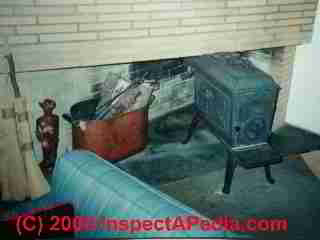
Above we illustrate two egregious examples of wood stove installations. The Jotl type woodstove (above left) is installed half in a weird (and improperly constructed) fireplace and half standing on carpeting.
The odd shape of the fireplace was creative but we suspect that it may not have performed well - another reason for adding the woodstove. This is an unsafe installation.
Placing a woodstove in a living room next to the couch (above right) is asking for a fire.
The process and temperatures under which wood deteriorates and becomes more readily combustible is also discussed
at SOLAR COLLECTOR WOOD HOUSINGS.
Convert a Zero-Clearance Fireplace to a Woodstove Installation
 Reader Question: who can install a woodstove where we have a zero clearance fireplace?
Reader Question: who can install a woodstove where we have a zero clearance fireplace?
I'd like your opinion as to what type of contractor I need, or if we need one at all.
We have a 1990's Lindal log home with a heatilator fireplace installed. I believe this is a zero clearance fireplace with no actual masonry except for the faux rock surrounding it.
We would like to have a wood burning stove instead. Either a stove on the hearth with the chimney going back inside the fireplace and up the existing flue/pipe, or remove the entire heatilator fireplace.
This is my choice and my husband votes for the prior.
If we remove the entire heatilator, I don't think there is any actual masonry inside the rectangular "chimney"....
So, we don't know if this is a major construction project that needs a Mason to do it, or if this is a simple task and a fireplace shop could do it. (Of course we'd have to buy their wood stove.
Can you tell me what kind of company I should be dealing with to take this on? - S.D. 11/30/2014
Reply:
We have moved this question and our reply to a separate article. Please
see WOOD STOVE INSTALL CONVERT
...
Reader Comments, Questions & Answers About The Article Above
Below you will find questions and answers previously posted on this page at its page bottom reader comment box.
Reader Q&A - also see RECOMMENDED ARTICLES & FAQs
On 2023-04-28 by InspectApedia Publisher
@John B -
This discussion has been moved to ASBESTOS MILLBOARD
On 2023-04-28 by John B - continued
I thought the was question was under the asbestos forum. I wanted to know if there were any asbestos fire-boards that look like the pictured item.
I think it’s just drywall, but since it’s around a purpose built built wood stove surround, wanted to see if if it could possibly be asbestos. It’s a demo going on in a home we are living in.
On 2023-04-24 by InspectApedia Editor (mod) - clearance distance, woodstove to oil or gas fired heaters
@Nate,
Thanks for the woodstove clearance distance question.
A careful consideration of safe clearance distances between a wood-burning appliance and an oil or gas fired heating appliance has to consider
- which fuel is being discussed
- hazards from heat of the wood-stove and its effect on not just the heater itself but its fuel distribution piping and fuel storage tank
- hazards from the wood stove serving as a potential point of ignition of the fuel or a fuel leak
- potential combustion air conflicts when both systems are operating simultaneously
- the underlying requirements for clearances from all combustibles and the woodstove
- the effects of any heat shields around the woodstove
- concerns for improperly-shared chimneys or venting systems
So just meeting the requirement of keeping the wood burning stove 36" to combustibles (48" for un-certified woodstoves) may not be enough.
A good place to start collecting these clearance distances is at
CLEARANCE DISTANCES for BUILDING SYSTEMS & FEATURES
If we start with simply the 10 foot required clearance distances for an oil storage tank, including from the tank to the oil burner itself, look at
OIL TANK FILL & VENT PIPE CLEARANCE DISTANCES
and
Oil tank distances at
ABOVE GROUND OIL STORAGE TANK (AST) INSPECTION - clearance distances
and
GAS TANKS LP / PROPANE storage tank clearance distances are given at
GAS METER CODES & CLEARANCE DISTANCES - distances from the gas meter to other site features - includes clearance distances to electrical wiring & conduit
GAS PIPING CLEARANCES, CODES & DEFECTS - clearances for gas piping
A minimum of 18 inches (457 mm) shall be maintained between gas or fuel-oil heat-producing appliances and combustible materials.
A minimum of 10 feet is required between an oil storage tank and the oil burner (unless a fire wall is built between them)
So surely, even where the code writers don't attempt to legislate every possible snafu we might think-up at a building, we ought to respect those as a starting point for clearance distance between woodstove and an oil or gas fired heater or fuel storage tank.
Another example of why people are scared of giving you a single number is the inability to predict important safety concerns that you may not anticipate such as a woodstove that seems to be at a very safe fire distance from a gas burner - but is stealing its combustion air, causing dangerous CO production in the building.
In sum you ask an important question but not one for which a single simple "answer" is safe and "right" for all of the possible circumstances of what equipment of what sort is installed where.
we point out that typical building code writers know that there is no single "right and always safe answer" so the code may just say
2703.7.2 Open flames.
Open flames and high-temperature devices shall not be used in a manner which creates a hazardous condition and shall be listed for use with the hazardous materials stored or used.
But rather than duck your question entirely, as we say in this article series,
... most likely your local code official will require the same fire clearance between a wood stove and oil storage tank as between the tank and other heating appliances - usually 10 feet is the minimum.
1. start with following the woodstove fire clearances given in the instructions from the manufacturer of the specific wood stove you're installing
2. review the woodstove fire clearance distance guidelines given above on this page.
3. Check that against the fire clearances given for the oil or gas fuel burning appliances at the same building - starting with those IO manuals as well as codes for those devices
On 2023-04-24 by Nate
Hi,
I regularly see woodstoves installed near heating systems. I can't seem to find a clear answer about the clearances. How far from a gas or oil fired heating system should a woodstove be?
Thanks.
On 2023-04-14 by InspectApedia Editor - does an interior door swung in any position be factored into combustible clearance?
@Anne,
Thanks, that's an important fire clearance question.
In my opinion the answer is absolutely, yes, a door that swings towards the stove must be included in fire clearances.
Simply consider what happens if someone leaves the door open against or too close to the stove - that could start a house fire.
Of course it would be more-helpful to see an actual photo or two (one per comment) of your actual installation and of door in question in both closed and open condition, with measurements of its distance from the stove. Otherwise we're talking theory, not a specifically analyzed event.
On 2023-04-14 by Anne
(re-posted by mod)
Hello, I am seeking clarification about door swing and combustible clearance for freestanding gas stove heaters such as this one:
- Link deleted as SOP for security of our readers & website malware protection
Is it correct that an interior door swung in any position must be factored into combustible clearance? And if so, am I correct in understanding that if an interior door swings so close to the heater as to sustain significant heat damage that it has not been installed with proper clearance (even if the door has proper clearance when closed)?
Thank you!
On 2022-12-07 by InspectApedia (Editor) - safe clearances and specs for wood burning stoves approved by insurance companies
@matt,
I expect any insurance company will approve wood stove installations that comply with BOTH the manufacturer's installation instructions and local codes - both of which specify clearances to combustibles.
On 2022-12-07 by matt
looking for safe clearances and specs for wood burning stoves approved
by insurance companies
On 2022-12-03 by InspectApedia (Editor) - what would be the NFI acceptable distance between Ashley AW40 wood burning heater and a type 2 heat shielded combustible wall
@Ted Price,
I appreciate the question but am afraid to guess at an answer as there are fire and life-safety concerns with any wood stove or wood stove exhaust flue clearance distances and I just don't have a full understanding of your installation.
Below are the clearance distances that your woodstove manufacturer requires, from p. 5 in your manual for the
ASHLEY AW40 INSTALLATION & USE MANUAL [PDF] Ashley Hearth Products, United States Stove Company, 227 Industrial Park Rd., South Pittsburg, TN 37380 USA Tel: (800) 750-2723 www.usstove.com
copy at
https://inspectapedia.com/chimneys/Ashley-Hearth-Products-AW40-Owners-Manual.pdf
I think there are multiple clearance distances of concern, including at the very least:
- woodstove to nearest combustibles
- flue vent connector to nearest combustible or wall
- flue vent / chimney clearance distances as it passes through the wall - to, for example, wood framing or insulation that might have a combustible vapor barrier
Insulated metal chimneys that may be rated for "zero clearance" may in some models actually want an inch of air space.
FIRE CLEARANCES, METAL CHIMNEYS - live link above in the Recommended Articles
has those details.
continuing
Please help me be more useful by explaining how you're using "NFI acceptable distance" where by convention NFI refers to
The Normed Fit Index (NFI)
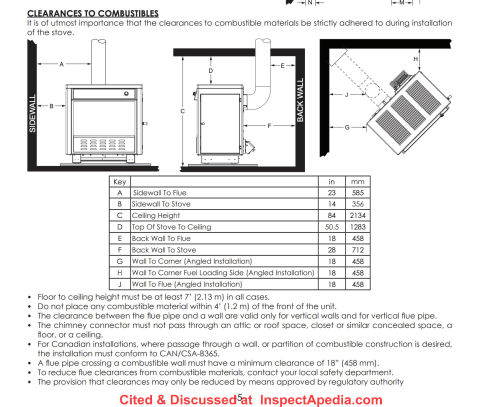
On 2022-12-02 by Ted Price
I have an Ashley AW40 wood burning heater which has a metal cabinet 100 % enclosure , except exhaust pipe port . My question is what would be the NFI acceptable distance between this type of heater and a type 2 heat shielded combustible wall ?
My double walled interior stove pipe will be straight , no elbows , between the heater and the Through-the-wall , stainless steel , insulated , double wall pipe , which leads to a selkirk stainless steel , insulated wall mount chimney system . Thanks . Ted Price
On 2022-11-04 by InspectApedia (Editor)
@Sheila,
Please see
FIRE CLEARANCES, METAL CHIMNEYS
On 2022-11-04 by Sheila
How far from an exterior standard vinyl window should Metalbestos piping for a woodstove be? Thanks
On 2022-10-19 by InspectApedia (Editor)
@Anonymous,
Sure, we're glad to show you where we provide that information in complete detail.
In the recommended articles found at the end of the article above we have the live link for
FIRE CLEARANCES, METAL CHIMNEYS
On 2022-10-19 1 by Anonymous
Clearences for double wall insulated stve pipe and wood burning stoves
On 2022-07-20 by InspectApedia-911 (mod)
@Gerald smith,
The article found above on this page includes pellet stove clearance distances.
But of course you should read the installation instructions for your specific brand and model stove as those may differ.
On 2022-07-20 by Gerald smith
Pellet stove, hearth distance from stove to sides and distance in front of stove, go
On 2023-04-14 by InspectApedia Editor (mod)
Thanks, that's an important fire clearance question.
In my opinion the answer is absolutely, yes, a door that swings towards the stove must be included in fire clearances.
Simply consider what happens if someone leaves the door open against or too close to the stove - that could start a house fire.
Of course it would be more-helpful to see an actual photo or two (one per comment) of your actual installation and of door in question in both closed and open condition, with measurements of its distance from the stove.
Otherwise we're talking theory, not a specifically analyzed event.
On 2023-04-14 by Anne: Empire direct vent gas stove clearance distances
Anne · 51 minutes ago
Hello, I am seeking clarification about door swing and combustible clearance for freestanding gas stove heaters such as this one:
- Link deleted as SOP for security of our readers & website malware protection
Is it correct that an interior door swung in any position must be factored into combustible clearance? And if so, am I correct in understanding that if an interior door swings so close to the heater as to sustain significant heat damage that it has not been installed with proper clearance (even if the door has proper clearance when closed)?
Thank you!
On 2022-12-07 3 by InspectApedia (Editor) (mod) - safe clearances & specs for woodstoves approved by insurance companies
@matt,
I expect any insurance company will approve wood stove installations that comply with BOTH the manufacturer's installation instructions and local codes - both of which specify clearances to combustibles.
You can find those above on this page and in the IO manual for your specific woodburning stove.
On 2022-12-07 by matt
looking for safe clearances and specs for wood burning stoves approved
by insurance companies
On 2022-12-03 y InspectApedia (Editor) (mod) - clearance distances for Ashley woodstoves
@Ted Price,
I appreciate the question but am afraid to guess at an answer as there are fire and life-safety concerns with any wood stove or wood stove exhaust flue clearance distances and I just don't have a full understanding of your installation.
Below are the clearance distances that your woodstove manufacturer requires, from p. 5 in your manual for the
ASHLEY AW40 INSTALLATION & USE MANUAL [PDF] Ashley Hearth Products, United States Stove Company, 227 Industrial Park Rd., South Pittsburg, TN 37380 USA Tel: (800) 750-2723 www.usstove.com
I think there are multiple clearance distances of concern, including at the very least:
- woodstove to nearest combustibles
- flue vent connector to nearest combustible or wall
- flue vent / chimney clearance distances as it passes through the wall - to, for example, wood framing or insulation that might have a combustible vapor barrier
Insulated metal chimneys that may be rated for "zero clearance" may in some models actually want an inch of air space.
FIRE CLEARANCES, METAL CHIMNEYS https://inspectapedia.com/chimneys/Metal_Chimney_Clearances.php
has those details.

continuing
Please help me be more useful by explaining how you're using "NFI acceptable distance" where by convention NFI refers to
The Normed Fit Index (NFI)
On 2022-12-02 by Ted Price
I have an Ashley AW40 wood burning heater which has a metal cabinet 100 % enclosure , except exhaust pipe port .
My question is what would be the NFI acceptable distance between this type of heater and a type 2 heat shielded combustible wall ?
My double walled interior stove pipe will be straight , no elbows , between the heater and the Through-the-wall , stainless steel , insulated , double wall pipe , which leads to a selkirk stainless steel , insulated wall mount chimney system . Thanks . Ted Price
On 2022-11-04 by Sheila
How far from an exterior standard vinyl window should Metalbestos piping for a woodstove be? Thanks 👍
On 2022-10-19 by InspectApedia (Editor) (mod) - Fire clearances for double wall insulated stove pipe and wood burning stoves
@Anonymous and
@Sheila,
Sure, we're glad to show you where we provide that information in complete detail.
In the recommended articles found at the end of the article we list
FIRE CLEARANCES, METAL CHIMNEYS
On 2022-10-19 by Anonymous
Clearences for double wall insulated stve pipe and wood burning stoves
On 2022-07-20 by InspectApedia-911 (mod) - Pellet stove, hearth distance from stove to sides and distance in front of stove
@Gerald smith,
The article found above on this page includes pellet stove clearance distances.
But of course you should read the installation instructions for your specific brand and model stove as those may differ.
On 2022-07-20 by Gerald smith
Pellet stove, hearth distance from stove to sides and distance in front of stove, go
On 2021-04-11 - by (mod) -
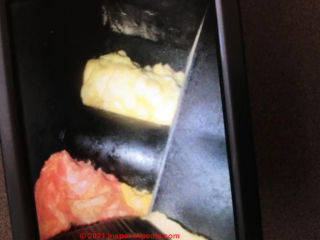 @Juli,
@Juli,
Fiberglass insulation won't actually burn - let's hope no kraft paper was included;
But I'd want to know the product name that was installed and to see its installation manual's instructions to be sure that the installation is correct and safe.
About the tall flue with cap, a PROPER UL-listed chimney cap ought not hurt draft and in fact ought to help it (preventing downdrafts)
but again you'll want to compare the flue dimensions = diameter and height = against the manufacturer's specs.
Finally: I think you're saying that a creosote-coated chimney flue was lined with a metal insert now connected to a fireplace insert.
I would ask your local fire inspector if she's ok with that or if she'd have wanted the creosote removed for fire safety
I would want to know if the insert is a multi-wall insulated zero clearance flue (safer) or a single thickness metal flue.
And I'd want to know from the fireplace insert manufacturer that they think a 6" flue is adequate.
On 2021-04-11 by Juli
I just had a fireplace invert put into a chimney which has creosote like varnish on it. The stove is connected to a new pipe which is zero clearance.
But the installer put household insulation around the pipe down at top of stove
And no cover over front of new stove
My question is can the insulation ignite
And burn layer of creosote varnish into the household
The man also put a tiny cap on the six inch pipe 17 feet tall and it is not drawing efficiently. Is this cap the problem?
On 2020-04-29 - by (mod) -
Anon
Woodstove clearance to an combustible surface, including an interior wall, is typically given as three feet.
Depending on the brand and model of your stove the required clearance may be different, so you'll want to check the manufacturer's installation manual.
On 2020-04-29 by Anonymous
What. Is. The. Clarence. From. Wall. To. Stove
What’s. The. Clearance. On. A. Wood stove. In west va. How. Many. Inches
On 2019-04-16 - by (mod) - woodstove installed 7" from a stone wall - OK?
Sharon
Who determined that the 7" from a stone wall was insufficient?
How is the stone wall constructed?
If you are talking about a solid stone-masonry wall then the clearance may not be a concern, but IF you are talking about a stone veneer over a combustible wood framed wall, you'd have to move the stove or you may be able to install an approved heat shield.
See details at HEAT SHIELD SPECIFICATIONS for WOOD STOVES & PELLET STOVES
and review that option with your local fire code inspector.
Watch out: Don't fudge - or you risk a house fire.
On 2019-04-16 by Sharon
A new wood stove has been installed in our cottage . 7 inches from the stone wall.
Apparently that is not far enough away. What can we do . MOve the stove and chimney (a great deal of work and expense) or cut out the wall.
On 2018-10-14 - by (mod) -
Rick
You'll find your question and a detailed reply at
PELLET STOVE CLEARANCE DISTANCES
https://inspectapedia.com/chimneys/Pellett-Stove-Fire-Clearances.php
On 2018-10-13 by Rick
Pellet stove instillation, how close can vent exhaust pipe be to outside pressure treated stairs running along my foundation?
...
Continue reading at HEAT SHIELD SPECIFICATIONS for WOOD STOVES & PELLET STOVES or select a topic from the closely-related articles below, or see the complete ARTICLE INDEX.
Or see WOOD STOVE PELLET STOVE FIRE CLEARANCE FAQs - questions and answers posted originally at this page
Or see these
Recommended Articles
- ASBESTOS MILLBOARD
- CHIMNEY CLEANING PROCEDURES
- CHIMNEY DRAFT & PERFORMANCE
- CHIMNEY FIRE ACTION / PREVENTION
- CHIMNEY FLUE INSPECTION CAMERA
- CREOSOTE FIRE HAZARDS
- DRAFT MEASUREMENT, CHIMNEYS & FLUES
- FIRE CLEARANCES INDOORS
- FIRE CLEARANCES, MASONRY CHIMNEYS
- FIRE CLEARANCES, METAL CHIMNEYS
- FIREPLACES & HEARTHS - home
- FIREPLACE INSERTS INSTALL, INSPECT, REPAIR - home
- GAS FIREPLACES & GAS LOGS - home
- WOOD-OIL COMBINATION HEATERS - home
- WOOD STOVE OPERATION & SAFETY - home
- COMBUSTION AIR for WOODSTOVES
- DEFECTS LIST - HEAT, WOOD APPLIANCE
- FIRE CLEARANCES, WOOD COAL & PELLET STOVES
- FIREPLACE INSERTS INSTALL, INSPECT, REPAIR
- HEAT SHIELD SPECIFICATIONS for WOOD STOVES & PELLET STOVES
- PELLET STOVE CLEARANCE DISTANCES
- PELLET STOVE DRAFT CONTROL
- PELLET STOVE MANUALS
- WOOD FURNACE FAN LIMIT CONTROL
- WOODSTOVE DRAFT CONTROL
- WOOD STOVE DRAFT TEST
- WOOD STOVE, CATALYTIC PUFF-BACKS
- WOOD STOVE INSTALL CONVERT
- WOOD STOVE INSPECTION CHECKLIST [PDF]
Suggested citation for this web page
FIRE CLEARANCES, WOOD COAL & PELLET STOVES at InspectApedia.com - online encyclopedia of building & environmental inspection, testing, diagnosis, repair, & problem prevention advice.
Or see this
INDEX to RELATED ARTICLES: ARTICLE INDEX to CHIMNEYS & FLUES
Or use the SEARCH BOX found below to Ask a Question or Search InspectApedia
Ask a Question or Search InspectApedia
Try the search box just below, or if you prefer, post a question or comment in the Comments box below and we will respond promptly.
Search the InspectApedia website
Note: appearance of your Comment below may be delayed: if your comment contains an image, photograph, web link, or text that looks to the software as if it might be a web link, your posting will appear after it has been approved by a moderator. Apologies for the delay.
Only one image can be added per comment but you can post as many comments, and therefore images, as you like.
You will not receive a notification when a response to your question has been posted.
Please bookmark this page to make it easy for you to check back for our response.
IF above you see "Comment Form is loading comments..." then COMMENT BOX - countable.ca / bawkbox.com IS NOT WORKING.
In any case you are welcome to send an email directly to us at InspectApedia.com at editor@inspectApedia.com
We'll reply to you directly. Please help us help you by noting, in your email, the URL of the InspectApedia page where you wanted to comment.
Citations & References
In addition to any citations in the article above, a full list is available on request.
- Travis Industries, "36 Elite Installation Manual, Wood-Burning Zero-Clearance Fireplace", Travis Industries House of Fire, 4800 Harbour Pointe Blvd. SW, Mukilteo, WA 98275, (2010), Website: http://www.travisindustries.com/ - retrieved 12/1/2014, original source: http://www.fireplacex.com/TravisDocs/93508090.pdf. This wood burning zero clearance fireplace was tested and listed by Omni Test Laboratories, Beaverton OR, Report # 028-F-60-4, meeting U.L. 127 & portions of UL 1482 & 907.
- Mark Cramer Inspection Services Mark Cramer, Tampa Florida, Mr. Cramer is a past president of ASHI, the American Society of Home Inspectors and is a Florida home inspector and home inspection educator. Mr. Cramer serves on the ASHI Home Inspection Standards. Contact Mark Cramer at: 727-595-4211 mark@BestTampaInspector.com
- John Cranor [Website: /www.house-whisperer.com ] is an ASHI member and a home inspector (The House Whisperer) is located in Glen Allen, VA 23060. He is also a contributor to InspectApedia.com in several technical areas such as plumbing and appliances (dryer vents). Contact Mr. Cranor at 804-873-8534 or by Email: johncranor@verizon.net
- Masonry Fireplace and Chimney Handbook, 2nd Ed., James E. Armhein, S.E., M.I.A. Masonry Institute of America, Los Angeles, CA 213-388-0472 prepared to include requirements of the 1994 UBC and other codes.
- Roger Hankeyis principal of Hankey and Brown home inspectors, Eden Prairie, MN, technical review by Roger Hankey, prior chairman, Standards Committee, American Society of Home Inspectors - ASHI. 952 829-0044 - hankeyandbrown.com
- Fire Inspector Guidebook, A Correlation of Fire Safety Requirements Contained in the 1987 BOCA National Codes, (newer edition available), Building Officials and Code Administrators International, Inc. (BOCA), Country Club HIlls, IL 60478 312-799-2300 4th ed. Note: this document is reissued every four years. Be sure to obtain the latest edition.
- Principles of Home Inspection: Chimneys & Wood Heating, in (Principles of Home Inspection), Carson Dunlop, Associates, Toronto, Ontario
- Uniform Mechanical Code - UMC 1991, Sec 913 (a.) Masonry Chimneys, refers to Chapters 23, 29, and 37 of the Building Code.
- New York 1984 Uniform Fire Prevention and Building Code, Article 10, Heating, Ventilating, and Air Conditioning Requirements
- New York 1979 Uniform Fire Prevention & Building Code, The "requirement" for 8" of solid masonry OR for use of a flue liner was listed in the One and Two Family Dwelling Code for New York, in 1979, in Chapter 9, Chimneys and Fireplaces, New York 1979 Building and Fire Prevention Code:
- "Top Ten Chimney (and related) Problems Encountered by One Chimney Sweep," Hudson Valley ASHI education seminar, 3 January 2000, contributed by Bob Hansen, ASHI
- Chimney Inspection Checklist, Carson Dunlop, Associates, Toronto, Ontario
- In addition to citations & references found in this article, see the research citations given at the end of the related articles found at our suggested
CONTINUE READING or RECOMMENDED ARTICLES.
- Carson, Dunlop & Associates Ltd., 120 Carlton Street Suite 407, Toronto ON M5A 4K2. Tel: (416) 964-9415 1-800-268-7070 Email: info@carsondunlop.com. Alan Carson is a past president of ASHI, the American Society of Home Inspectors.
Thanks to Alan Carson and Bob Dunlop, for permission for InspectAPedia to use text excerpts from The HOME REFERENCE BOOK - the Encyclopedia of Homes and to use illustrations from The ILLUSTRATED HOME .
Carson Dunlop Associates provides extensive home inspection education and report writing material. In gratitude we provide links to tsome Carson Dunlop Associates products and services.


